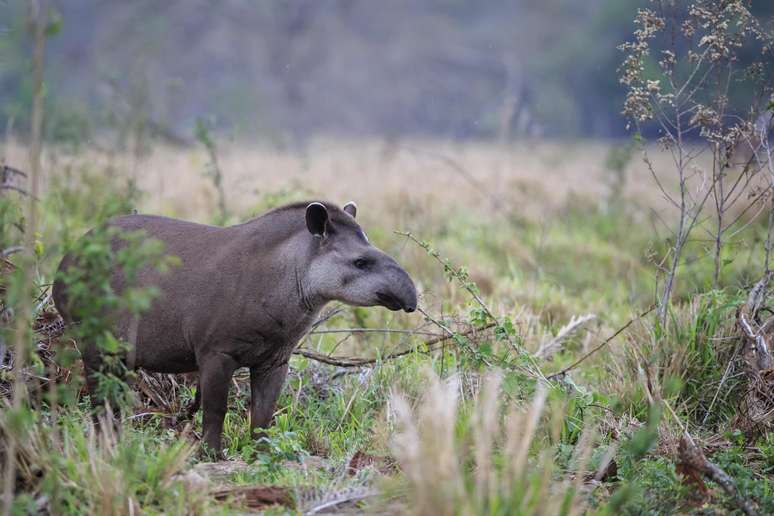The Brazilian tapir appears as “vulnerable to extinction” on the IUCN Red List
The largest land mammal in South America still arouses curiosity around it. From solitary behavior to the incorrect use of one’s name in a pejorative sense, Brazilian tapir brings with it some particularities weighing from 180 to 300 kilos and measuring from 1.10 to 2 metres.
Receive the main news directly on WhatsApp! Subscribe to the Terra channel
Even with this size, the species does not escape being defined as “vulnerable to extinction” in the International Union for Conservation of Nature (IUCN) Red List. Despite having the jaguar as its main predator, the animal lives with other worries.
In conversation with the EarthPatricia Medici, coordinator of the National Initiative for the Conservation of the Brazilian Tapir, explained that the context of the species varies depending on the environment in which it is found in nature.
The dangers, however, are almost always the same and, most of the time, are caused byhuman action, both directly with sport and subsistence hunting, and as a consequence of other human activities.
“The main threats today are road accidents, large fires, deforestation and habitat fragmentation. Pesticide contamination is a factor that we have detected here in Mato Grosso do Sul,” explains the researcher.
Along with these threats, the reproductive cycle of approximately 13 months makes survival difficult. In addition to the long gestation, the female produces only one offspring at a time, which may or may not survive.
According to the IUCN, the tapir is present in Argentina, Bolivia, Colombia, Ecuador, French Guiana, Guyana, Paraguay, Suriname and Venezuela, as well as in Brazil, in South America. In Brazil its presence is found in the Amazon, Pantanal,. Cerrado and Atlantic Forest.
In all of these biomes, a possible extinction of the species could have a significant impact on the ecosystem. Researchers have even nicknamed him the “forest gardener”, such is his importance.
“It is herbivorous, eats a lot of fruit and disperses the seeds of these fruits through its feces. These are animals that have very large home ranges, they move over long distances and during these large movements they defecate and disperse the seeds that they consume along the way. So they create biodiversity and maintain biodiversity and greatly influence the composition of the habitat,” explains Medici.
With the silent work carried out by the tapir, the future could have a degraded forest without adequate maintenance of plant species, in case of absence of the species, according to the coordinator of INCAB-IPÊ.
But, after all, why is tapir used pejoratively?
There is no exact answer to the question. When a person calls another “tanta”, most of the time they want to define the listener as stupid or unintelligent.
Despite popular imagination, the use of the word is far from representing the reality of the species. According to INCAB-IPÊ, studies on the number of neurons in the brain have confirmed that the tapir is an intelligent animal.
With this controversy, theories about the origin of the word as a crime vary. In one of them it is believed that the colonizers failed to domesticate the tapirs and, due to the animal’s somewhat truculent escapes, they defined it as “mute”.
Another line of thought goes in the opposite direction. Because it is rather docile, there are those who believe that the tapir is a “wounded” species, as explained by Medici, who has a favorite theory.
“But if I had to bet, I would bet on the fact that the colonizers failed to accustom this animal to services and therefore it must have had this reputation as a stupid animal. This is my big bet,” he underlines.
What is tapir behavior like?
One of the main characteristics of the tapir is its solitary and nocturnal side. Medici explains that, normally, the animal is seen accompanied only by males and females during the breeding season.
Another point to highlight is that, despite being more common in forests, the species also lives in open areas in the cerrado, and in flooded areas and swamps in the Pantanal. Despite being a terrestrial animal, the tapir has a good relationship with water, also using it to mate.
Food is another striking feature of the tapir, a herbivorous animal. About 60% of their diet is based on wild fruits, mainly palms.
Source: Terra
Rose James is a Gossipify movie and series reviewer known for her in-depth analysis and unique perspective on the latest releases. With a background in film studies, she provides engaging and informative reviews, and keeps readers up to date with industry trends and emerging talents.





-1h7z8ugdh88jb.jpg)


